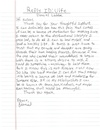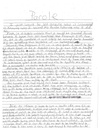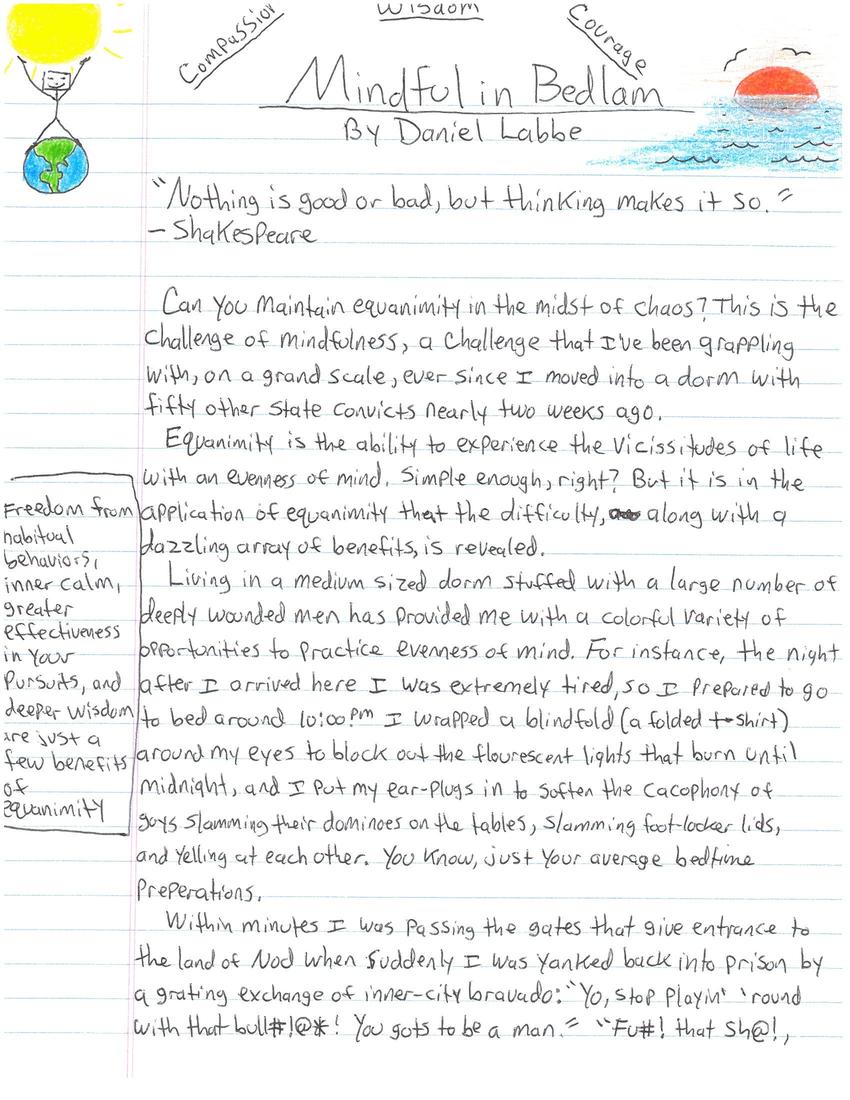
Transcription
Compassion, Wisdom, Courage
Mindful in Bedlam
By Daniel Labbe
"Nothing is good or bad, but thinking makes it so."
- Shakespeare
Can you maintain equanimity in the midst of chaos? This is the challenge of mindfulness, a challenge that I've been grappling with, on a grand scale, ever since I moved into a dorm with fifty other state convicts nearly two weeks ago.
Equanimity is the ability to experience the vicissitudes of life with an evenness of mind. Simple enough, right? But it is in the application of equanimity that the difficulty, along with a dazzling array of benefits, is revealed.
[Freedom from habitual behaviors, inner calm, greater effectiveness in your pursuits, and deeper wisdom are just a few benefits of equanimity]
Living in a medium sized dorm stuffed with a large number of deeply wounded men has provided me with a colorful variety of opportunities to practice evenness of mind. For instance, the night after I arrived here I was extremely tired, so I prepared to go to bed around 10:00 pm. I wrapped a blindfold (a folded T-shirt) around my eyes to block out the fluorescent lights that burn until midnight, and I put my ear-plugs in to soften the cacophony of guys slamming their dominoes on the tables, slamming foot-locker lids, and yelling at each other. You know, just your average bedtime preparations.
[Check out the book Dhamma Brothers, by Jenny Phillips to see how equanimity and mindfulness changed the lives of 20 inmates in an Alabama maximum security state prison.]
Within minutes I was passing the gates that give entrance to the land of Nod when suddenly I was yanked back into prison by a grating exchange of inner-city bravado: "Yo, stop playin' 'round with that bull#!@*! You gots to be a man." "Fu#! that sh@!, nigga, I do's what I wants!" and on and on it went with voices turned up to super-macho. My earplugs just weren't up to the challenge. What do these guys think they're doing? I thought. Can't these guys see I'm sleeping? They were gathered around my bunkbed, and I felt disrespected. The old "no one's gonna disrespect me" thought was dancing through my head, but then the mindfulness training kicked in.
[1. Breathe.
2. FEEL the emotion.
3. Become aware of the impulse to engage in a habitual behavior
4. DON'T react
5. Breathe]
"Breathe", I told myself. "Allow yourself to FEEL the anger. Observe the thoughts, and above all, DON'T react. Experience it all with cool equanimity." After a minute of this I realized that saying something to these hyped-up guys might not have been in my best interest. It then occurred to me that they too are living in prison, they too are suffering, confused, and want to feel good. In that light I was able to see their behavior as a symptom of their woundedness, their conditioning, and the fear that comes with living in a threatening environment. In other words, I FELT A CONNECTION WITH THEM. Suddenly, I knew what to do.
Rather than say anything, I simply say up, took off my blindfold, and gave them a genuine smile. It took all of about thirty seconds until one of the men apologized to me and led his friends away. Within minutes I was back in the land of Nod.
If equanimity can work in this extreme environment, what can it do under normal day to day conditions?
At its best equanimity is deeply healing and transformative. It reveals to us how much of our suffering is the result of our automatic and habitual ways of reacting to life. When we practice evenness of mind we become acutely aware of all that disturbs this evenness, which in turn helps us become aware of our habitual reactions and how they contribute to our experience. Normally we don't notice our reactions. We react unconsciously believing we are freely thinking and responding in totally natural ways, but mindfulness and equanimity reveal this fantasy for what it is - a self-protective guise that causes much of our troubles.
[How much of our thoughts and behavior are merely conditioned reactions? What is their effect?]
With equanimity we notice the distorted thoughts and habitual reactions that fuel our suffering instead of blindly engaging them. This comes as quite a startling realization but the deepest healing and freedom begins when through the practice of equanimity we are forced to experience the difficult emotions and thoughts that our protective habits have been protecting us from. These protective habits no longer serve us. We must face and sit with the buried emotions and thoughts that have been unconsciously driving the reactive behavior causing us so much trouble. For many of us this will be the first time we've allowed ourselves to feel deep hurt, guilt, sadness, humiliation, or shame WITHOUT REACTING TO THEM in many, many years. This is a deeply healing and liberating process.
It isn't long before we can experience these once buried emotions without reacting in old, habitual ways. We'll notice a decrease in angry outbursts, aloofness, judging mind, the need to fix or figure out everything, drug/alcohol use, and exaggerated thoughts, to name a few protective reactions. The key is to allow ourselves to feel the impulse to engage in these behaviors as we experience strong emotions and to NOT react.
Give equanimity a shot. It's the most powerful way to uncover the driving forces behind our most troublesome behaviors and emotions. Then come back and share your experience.
-Peace-
If you enjoyed this post feel free to transcribe it or email it to a friend, or both! Thank you
Questions? Comments? Feel free to leave a comment or write me at:
Daniel Labbe W85867
PO Box 43
Norfolk, MA 02056
Other posts by this author
|
2016 aug 4

|
2016 jun 25

|
2016 jun 9

|
2016 may 5

|
2016 mar 11

|
2016 feb 7

|
More... |




Replies